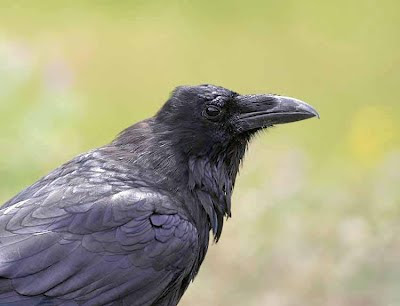While we ate breakfast, we saw two baby rabbits just outside the window. At the Olympic winter training camp, Berry found a huge turtle. Its shell was 20 inches across. It was burying eggs in the mud next to Teal Lake. Heedless deer leaped across the road when we were deep in the forest. There was a lot going on.
It rained off and on all day. Rain does not ruin birding at all; it does drive human beings indoors... which leaves municipal parks, wildlife nature centers and public boat ramps empty for us. Here in the Upper Peninsula of Michigan there are cattails everywhere. There are small ponds and bogs all over the place. The whole peninsula is like a giant sponge. The receptionist at the hotel denied that it rains all the time here. "It's just Spring," she said.
We spotted a Common Raven (Corvus corax) in a small town called Champion. The raven looks like an American Crow, but its beak is larger. Nice addition to our list. Then we got lost in the woods. Next to a stream, there were Yellow Rumped Warblers (Dendroica coronata) which we also had seen in Mexico. Then, we asked directions on how to get back to the highway.
 |
Driving through the rain, we saw a Bald Eagle (Haliaeetus leucocephalus) making circles in the sky. We bought Nancy a gift for her helping us during our vacation. Then we ate lunch in the car during the pouring rain: ham and cheese on crackers with a squirt of mustard. This kept us from having to leave the forest and drive around to find a town with a diner just to eat lunch.
 |
Amazing! Incredible! We found a Ruffed Grouse (Bonasa umbellus) strutting proudly in his ruffled finery. This is something even most serious birders have never seen. An adult male Ruffed Grouse, displaying his neck feathers in a ceremonial courtship display. It looks like he has a large feather boa around his neck.
 |
Down the road from him, I spotted an Olive-Sided Flycatcher (Contopus cooperi), perched on the top-most branches of a tree. Its olive colored "vest" and the white stripe down the front of this bird are diagnostic. Unlike most other flycatchers, the Olive Sided Flycatcher is not in the genus Empidonax, but in the genus Contopus... it is a pewee, not a flycatcher.
 |
We made over it to the Keweenaw Peninsula in the northwest corner of the Upper Peninsula and added two more birds to our "Life List". Nice day of birding.
Robertphotos courtesy of tmunson, rfowler, tsohl and trdavis

No comments:
Post a Comment